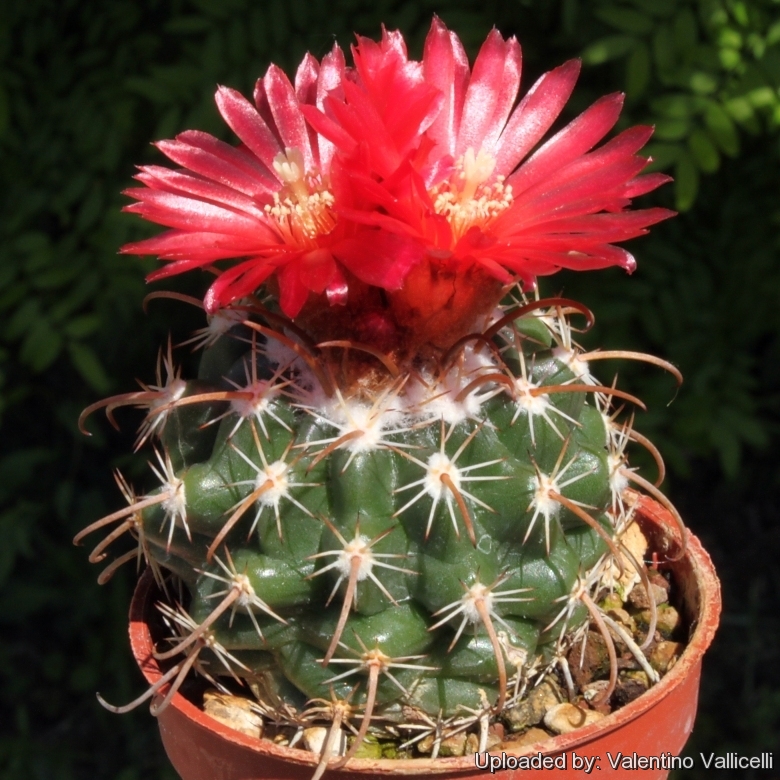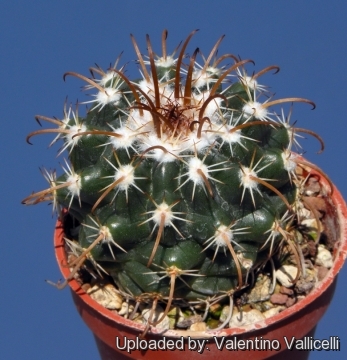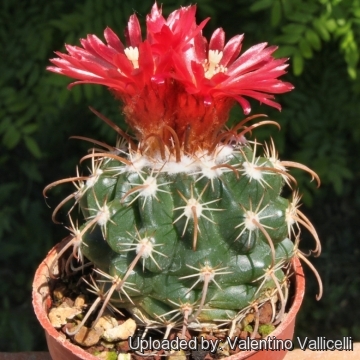Accepted Scientific Name: Parodia subterranea F.Ritter
Succulenta (Netherlands) 1964, 43 (1964)

Parodia culpinensis Photo by: Valentino Vallicelli
Origin and Habitat: Native to Bolivia, Chuqisaca (Culpina, Salitre, La Cueva, Miskha Pampa, Yuquina, Cinti, La Torre, Caña Cruz, San Pedro, Camargo)
Altitude: It grows at elevations of 2800 to 3600 metres above sea level.
Habitat: The species grows in puna grassland with very stony ground and little vegetation cover. The climate conditions are dry, with scarce rains. During the dry time, the plant bodies tend to retract and hide into the ground and is extremely hard to find unless it is in bloom.
Note: The indigenous word "Puna" indicate the western region up to 4500 m that extends from the Peru, going throughout Bolivia to the Argentinian North. Delimited at west by a costal chain of high volcanic picks and by the Cordillera mountainous chain to the east. The Argentinian Puna is the natural continuation of the Bolivian highland.
Synonyms:
See all synonyms of Parodia subterranea
back
Accepted name in llifle Database:Parodia subterranea F.RitterSucculenta (Netherlands) 1964, 43 (1964)Synonymy: 8
Accepted name in llifle Database:Parodia subterranea var. occulta (F.Ritter) RomulskiKaktusy Inne 3(2): 77. 2006; cf. Repert. Pl. Succ. 57: 12. 2007Synonymy: 3
back
Description: Parodia culpinensisSN|5868]]SN|5873]] is one of the local or morphological forms of the variable Parodia subterraneaSN|5873]]SN|5868]] distingushed from the latter by it longer hooked central spines and larger red flowers opening in the afternoon.
Habit: Usually simple or rarely basally branched.
Stem: Flattish to globose, 6-12 cm in diameter, dull green to olive green with white wool apically, thick and growing mostly underground, but the plant's stem in cultivation is usually globular or ovoidal and aerial.
Ribs: 11-13 spiralling, forming distinct conical tubercles.
Areoles: Young areoles are filled with abundant white wool. Later they are naked.
Central spines: Usually one (or sometime as many as 4), thick creamy white, to brownish or black, clawlike, more or less erect hooked and twisted (depending on population), up to 3 cm long.
Radial spines: Up to 10, radiating, more or less flattened against the plant's body, mostly whitish or yellowish, 5-8 mm long.
Flowers: Funnel-shaped, usually red, 3-4(-5) cm wide. Pericarpel and floral tube covered with white or brown hairs and black bristles. Dried flowers remain for a long time on the plant's body after blooming.
Blooming season: Late spring.
Fruit: Red or green, with white hairs.
Seeds: Purse shaped, black.
Subspecies, varieties, forms and cultivars of plants belonging to the Parodia subterranea group
 Parodia culpinensis F.H.Brandt: has longer hooked central spines up to 3 cm long and larger red flowers opening in the afternoon. Distribution: Chuqisaca (Culpina, Cinti and adjacent areas)
Parodia culpinensis F.H.Brandt: has longer hooked central spines up to 3 cm long and larger red flowers opening in the afternoon. Distribution: Chuqisaca (Culpina, Cinti and adjacent areas) Parodia subterranea F.Ritter: has flattish almost undergroung stems 6-12 cm in diameter. Central spines 1-4, very short straight or hooked 7-14 mm long and up to 10, radiating radials 5-8 mm long. Distribution: Chuqisaca (Culpina, Cinti)
Parodia subterranea F.Ritter: has flattish almost undergroung stems 6-12 cm in diameter. Central spines 1-4, very short straight or hooked 7-14 mm long and up to 10, radiating radials 5-8 mm long. Distribution: Chuqisaca (Culpina, Cinti)- Parodia subterranea var. occulta (F.Ritter) Romulski
Bibliography: Major references and further lectures
1) Tony Mace “Notocactus: a review of the genus incorporating Brasilicactus, Eriocactus and Wigginsia” Editorial Board/National Cactus & Succulent Society, 1975
2) Edward Anderson “The Cactus family” Timber Press, Incorporated, 2001
3) James Cullen, Sabina G. Knees, H. Suzanne Cubey "The European Garden Flora Flowering Plants: A Manual for the Identification of Plants Cultivated in Europe, Both Out-of-Doors and Under Glass" Cambridge University Press, 11/Aug/2011
4) David R Hunt; Nigel P Taylor; Graham Charles; International Cactaceae Systematics Group. "The New Cactus Lexicon" dh books, 2006
5) Lowry, M. & Carr, J. 2013. Parodia subterranea. In: IUCN 2013. "IUCN Red List of Threatened Species." Version 2013.1. <www.iucnredlist.org>. Downloaded on 28 October 2013.
 Parodia culpinensis Photo by: Valentino Vallicelli
Parodia culpinensis Photo by: Valentino Vallicelli Parodia culpinensis Photo by: Valentino Vallicelli
Parodia culpinensis Photo by: Valentino Vallicelli Parodia culpinensis Photo by: Valentino Vallicelli
Parodia culpinensis Photo by: Valentino VallicelliSend a photo of this plant.The gallery now contains thousands of pictures, however it is possible to do even more. We are, of course, seeking photos of species not yet shown in the gallery but not only that, we are also looking for better pictures than those already present.
Read More... Cultivation and Propagation: Water these plants regularly, and fertilize them with a low nitrogen fertilizer every 6 to 8 weeks, from mid-spring to late summer. This plant should remain rather dry at other times (especially in winter), except for a quick, periodic misting on warmer days in late winter. If it is kept absolutely dry for a long period, it tends to lose its roots in winter. It can tolerate light frost (- 4C°) but rots easily if wet and cold.
If the local climate is warm enough to grow this plant outside, be sure that soil is well drained and sun is full, but with protection from strong midday rays.
Propagation: By Seeds that are very fine.














